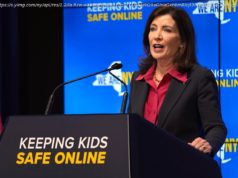Trump’s claim that US is cleanest lacks support from studies
President Donald Trump said the United States « will continue to be the cleanest and most environmentally friendly country on Earth » as he announced a U. S. pullout from an international accord designed to curb climate change .
But facts muddy that claim.
Data show that the U. S. is among the dirtiest countries when it comes to heat-trapping carbon pollution. One nation that has cleaner air in nearly every way is Sweden.
« The U. S. is well behind other countries in having the cleanest and most sustainable environment, » University of Michigan environmental scientist Rosina Bierbaum said in an email.
The U. S. emits more carbon dioxide than any other nation except China. In 2014, the U. S. spewed 237 times more carbon dioxide into the air than Sweden, according to figures by the U. S. Department of Energy’s Oak Ridge National Laboratory.
« On pretty much any climate-related indicator, the U. S. will not look good, » said Glen Peters, a Norwegian climate scientist who is part of the Global Carbon Project that ranks worldwide emissions.
The U. S. is No. 2 in per person carbon dioxide pollution, behind Luxembourg, among 35 developed nations plus China, India and Brazil, Energy Department data show. That’s 19.1 tons (17.3 metric tons) of carbon dioxide per year for the average American, compared with 4.9 tons (4.5 metric tons) for the average Swede.
Taking into account economics, the U. S. ranks 10th highest in carbon pollution per gross domestic product behind China, India, Russia, Estonia, Poland, South Korea, the Czech Republic, Mexico and Turkey, according to the International Energy Agency. The U. S. spews almost five times more carbon dioxide per dollar in the economy than Sweden.
Because carbon dioxide stays in the atmosphere for more than a century, scientists and regulators say it’s more important to look at historical emissions. Since 1870, the U. S. has produced about one-quarter of the world’s carbon dioxide — twice as much as China — and that makes it the biggest polluter in the world by far, Peters said.
In some traditional air pollution measurements, the United States is cleaner than most nations, said William K. Reilly, who headed the U. S. Environmental Protection Agency under Republican President George H. W. Bush.
But « when the problem he is dealing with is carbon dioxide, we are notably not better than the rest of the world, » said Reilly, adding that Trump is « just wrong. »
The U. S. is better than most of the world when it comes to dangerous soot or fine particles. Among industrialized countries, the U. S. tied for sixth cleanest, according to the Health Effects Institute.
It’s also tied for sixth smoggiest in the world with Turkey, according to the institute .
« There are a number of countries that have cleaner air in terms of major industrial nations. We are certainly in the top core, » said Dan Greenbaum, the group’s president. « Clearly, countries like China and India are much, much worse than we are. »
The U. S. leads in helping people fight for a clean environment by having laws and procedures that allow citizens to sue to enforce pollution protections and get information, said Princeton University climate scientist and international affairs professor Michael Oppenheimer.
Other countries are far ahead of the U. S. in cleaner energy, especially Germany, which on occasion is fueled fully by renewables, Oppenheimer said.
Reilly, the former EPA head, recalled how the U. S. took environmental leadership 25 years ago this month as it became the first industrial country to ratify the first climate treaty.
« Now we turn the page, » Reilly said. « We’ll see where it goes. »
———
Online:
Interactive on temperature deviation and global emissions: http: //interactives.ap.org/2017/climate-change-temps
———
Follow Seth Borenstein on Twitter at @borenbears. His work can be found here.






